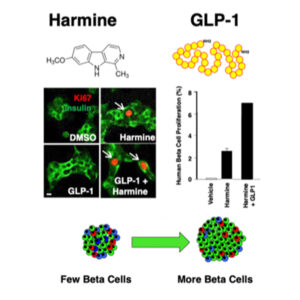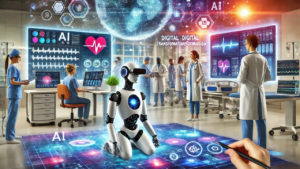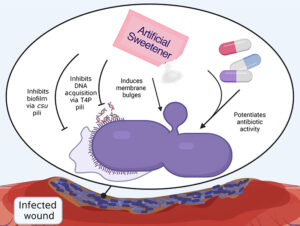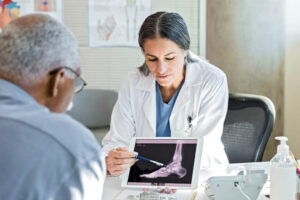In this week’s issue of The Savvy Diabetic:
- Diabetes Treatment Breakthroughs: Harmine to Stimulate Beta Cell Replication; Sana BioTechnology Islet Transplantation without Immunosuppression, AI-powered insulin delivery system
- Saccharin Kills Multidrug-Resistant Bacteria
- D & Bone Health: How to Support Your Skeleton
- Avoiding Hypos During Exercise with Drs. Steve Edelman & Jeremy Pettus
- GlucoSense App Simplifies T1D Management
Emerging Breakthroughs In Diabetes Treatment: A New Era Of Hope by Juergen Eckhardt for Forbes.com, 18 March 2025.
 The Quest For a Simple Pill: For over 15 years, researchers at the Icahn School of Medicine at Mount Sinai have been at the forefront of diabetes research, striving to identify a drug capable of inducing the regeneration of human beta cells. In a significant breakthrough in 2015, they discovered harmine, a small molecule that is capable of stimulating beta cell replication. Esra Karakose, assistant professor in the Department of Medicine, is now studying the mechanism of action, and her team’s latest publication from an in vitro study suggests that harmine is inducing “fate conversion,” where alpha cells—another type of pancreatic cell—transform into beta-like cells capable of producing insulin.
The Quest For a Simple Pill: For over 15 years, researchers at the Icahn School of Medicine at Mount Sinai have been at the forefront of diabetes research, striving to identify a drug capable of inducing the regeneration of human beta cells. In a significant breakthrough in 2015, they discovered harmine, a small molecule that is capable of stimulating beta cell replication. Esra Karakose, assistant professor in the Department of Medicine, is now studying the mechanism of action, and her team’s latest publication from an in vitro study suggests that harmine is inducing “fate conversion,” where alpha cells—another type of pancreatic cell—transform into beta-like cells capable of producing insulin.
Intriguingly, another group of researchers, including Andrew Stewart and Peng Wang, published another recent study in which they gave harmine alone or in combo with a GLP 1, to mice transplanted with human pancreatic islet cells. Harmine increased the human beta cell mass by 300% with harmine alone, and by 700% in combination with a GLP 1.
 Potentially Groundbreaking Cell Therapy: In parallel, Sana Biotechnology is pioneering a revolutionary approach to islet cell transplantation for type 1 diabetes that circumvents the need for immunosuppression. Sana’s approach, which includes gene modifications to create cells that evade both allogeneic and autoimmune detection, could fundamentally change the landscape of diabetes treatment. For the recently announced study, the transplanted cells came from a cadaver, after which they were engineered to evade immune rejection. The next step in the program, says Steve Harr, the President and CEO of Sana, is to move away from cadaver-sourced cells, which provided a proof of concept, and instead use genetically modified pluripotent stem cells. Those could be grown into pancreatic cells suitable for transplant. There’s a virtually unlimited supply of stem cells that could be scaled up for such a commercial effort.
Potentially Groundbreaking Cell Therapy: In parallel, Sana Biotechnology is pioneering a revolutionary approach to islet cell transplantation for type 1 diabetes that circumvents the need for immunosuppression. Sana’s approach, which includes gene modifications to create cells that evade both allogeneic and autoimmune detection, could fundamentally change the landscape of diabetes treatment. For the recently announced study, the transplanted cells came from a cadaver, after which they were engineered to evade immune rejection. The next step in the program, says Steve Harr, the President and CEO of Sana, is to move away from cadaver-sourced cells, which provided a proof of concept, and instead use genetically modified pluripotent stem cells. Those could be grown into pancreatic cells suitable for transplant. There’s a virtually unlimited supply of stem cells that could be scaled up for such a commercial effort.
“A cure for type 1 diabetes is now inevitable,” Harr says. “All the component parts have happened. The only things patients have to worry about are time, capital, safety, and scale.
 The Role of Artificial Intelligence: A new clinical trial at the University of Virginia aims to assess an AI-powered insulin delivery system that utilizes reinforcement learning to improve automated insulin delivery. This system, known as the Bolus Priming System with Reinforcement Learning (BPS_RL), represents a significant leap forward in diabetes management. The updated software system seeks to close this loop, automating the dosing process based on glucose history and meal detection. By eliminating the need for user intervention, this technology promises to enhance blood sugar control, particularly during meals and overnight, thereby improving the quality of life for individuals living with diabetes.
The Role of Artificial Intelligence: A new clinical trial at the University of Virginia aims to assess an AI-powered insulin delivery system that utilizes reinforcement learning to improve automated insulin delivery. This system, known as the Bolus Priming System with Reinforcement Learning (BPS_RL), represents a significant leap forward in diabetes management. The updated software system seeks to close this loop, automating the dosing process based on glucose history and meal detection. By eliminating the need for user intervention, this technology promises to enhance blood sugar control, particularly during meals and overnight, thereby improving the quality of life for individuals living with diabetes.
Read more: Emerging Breakthroughs In Diabetes Treatment: A New Era Of Hope
Artificial sweetener shows surprising power to overcome antibiotic resistance by Hayley Jarvis for Brunel University and published by Phys.org, 4 April 2025.
 Saccharin, the artificial sweetener used in diet foods like yogurts and sugar-free drinks, can kill multidrug-resistant bacteria—including one of the world’s most dangerous pathogens. “Antibiotic resistance is one of the major threats to modern medicine,” said Professor Ronan McCarthy, who led the research at Brunel University of London’s Antimicrobial Innovations Center. “Doctors are increasingly facing cases where the drugs no longer work.”
Saccharin, the artificial sweetener used in diet foods like yogurts and sugar-free drinks, can kill multidrug-resistant bacteria—including one of the world’s most dangerous pathogens. “Antibiotic resistance is one of the major threats to modern medicine,” said Professor Ronan McCarthy, who led the research at Brunel University of London’s Antimicrobial Innovations Center. “Doctors are increasingly facing cases where the drugs no longer work.”
“In exciting work led by our team, we’ve identified a novel antimicrobial—saccharin,” Prof McCarthy said. “Saccharin breaks the walls of bacterial pathogens, causing them to distort and eventually burst, killing the bacteria. Crucially, this damage lets antibiotics slip inside, overwhelming their resistance systems.”
Saccharin has been part of the human diet for longer than 100 years. While it has been extensively tested for safety in people, little was known about its effect on bacteria—until now, with a study appearing in EMBO Molecular Medicine. The international team found that saccharin stops bacterial growth, disrupts DNA replication, and stops the bacteria from forming biofilms—sticky, protective layers that help them survive antibiotics. They also created a saccharin-loaded hydrogel wound dressing that, in tests, outperformed market-leading silver-based antimicrobial dressings currently used in hospitals.
“This is very exciting,” Prof McCarthy added. “Normally, it takes billions of dollars and decades to develop a new antibiotic. But here we have a compound that’s already widely used, and it not only kills drug-resistant bacteria but also makes existing antibiotics more effective.
Read more: Artificial sweetener shows surprising power to overcome antibiotic resistance
Diabetes and Bone Health: How to Support Your Skeleton by Gina Woods for TCOYD.org, 25 March 2025.
 Not everyone knows that diabetes can also have a significant impact on bone health. This lesser-known complication of diabetes, often referred to as “diabetic osteopathy,” is an important consideration for those living with diabetes. The chronic inflammation associated with obesity, combined with the effects of hyperglycemia, can weaken bones and lead to a higher risk of fractures and poor fracture healing. Here’s what we need to know:
Not everyone knows that diabetes can also have a significant impact on bone health. This lesser-known complication of diabetes, often referred to as “diabetic osteopathy,” is an important consideration for those living with diabetes. The chronic inflammation associated with obesity, combined with the effects of hyperglycemia, can weaken bones and lead to a higher risk of fractures and poor fracture healing. Here’s what we need to know:
Dr. E’s Case Study: 4 Tips to Avoid Hypoglycemia During Exercise with Type 1 Diabetes by Dr. Steve Edelman for TCOYD.org, 25 March 2025.
Watch Dr. Jeremy Pettus and Dr. Steve Edelman in their exercise challenge where they competed to see who had the better blood sugar management strategy. They both went up and down – you be the judge of who won!
Read more: 4 Tips to Avoid Hypoglycemia During Exercise with T1D
-
- The GlucoScore: Every day GlucoSense provides single, simple score from 1-10 to help you understand your overall glucose level management, helping you track progress and make more informed decisions about your health.
- Lifestyle Insights: GlucoSense provides simple, understandable insights that show you how meals, exercises, and daily habits affect your glucose, making it easier to adjust for a healthier lifestyle.
- AI Carb Counting: GlucoSense allows you estimate the carbs in your food in less than 10 seconds by taking a photo or providing a short description of your food.
- Device Integrations: No extra devices needed. GlucoSense connects with your favorite continuous glucose monitors (Dexcom & Freestyle Libre) and fitness trackers (Apple Watch, Oura, WHOOP, Garmin, and Fitbit)
Listen to Stacey Simms with Jonathan Fitch, founder of GlucoSense.
Read more:




Hey, I like the new format. It rocks!! Now, as for the information, I am hopeful that the cell therapy works out. Do you think it would ever apply to one of us multi-autoimmune people? I am so doubtful.
I saw that a buddy of ours is in the second part of screening for the Vertex Pharmaceuticals trial. I know she is so hopeful, as I am hopeful for her. I am so hopeful